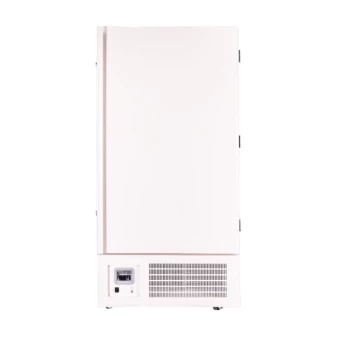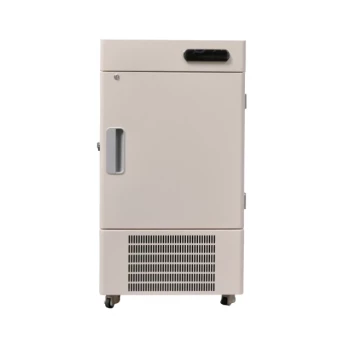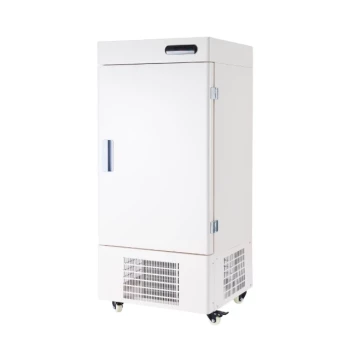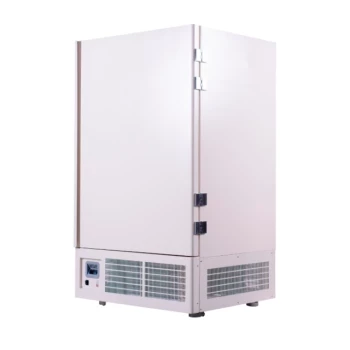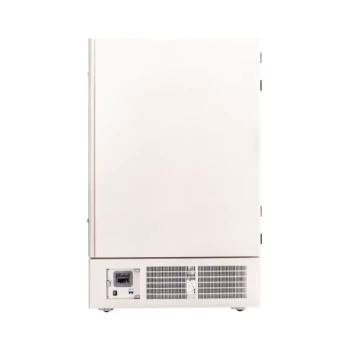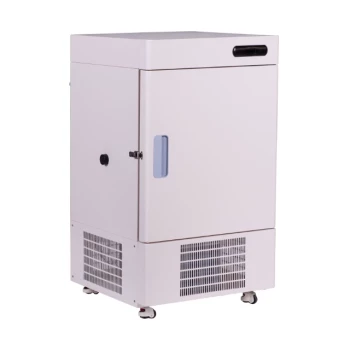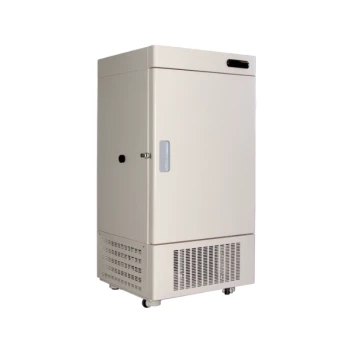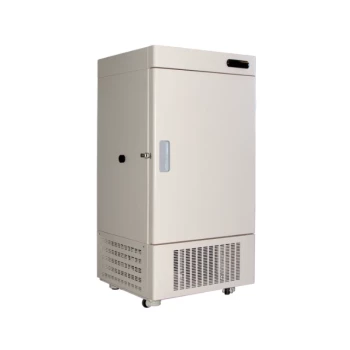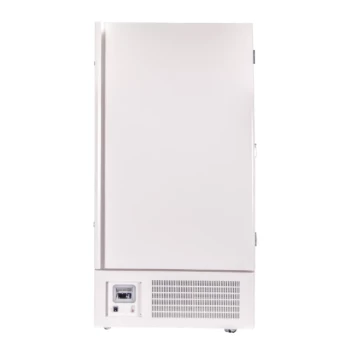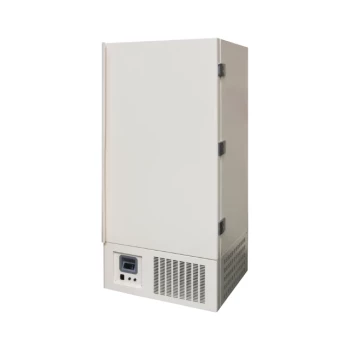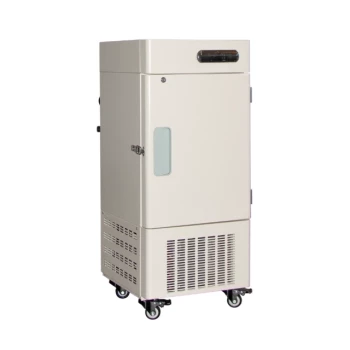The standard method for storing biological samples in an Ultra-Low Temperature (ULT) freezer is a multi-layered system of organization. Samples are first placed in specialized polymer tubes or microtubes, which are then arranged into grid-divided storage boxes. These boxes, typically made of cardboard or plastic, are then loaded into metal racks that fill the interior of the freezer.
The core challenge of ULT storage isn't just achieving low temperatures; it's about maintaining sample integrity, maximizing space, and ensuring rapid, safe access. The standardized system of tubes, boxes, and racks is the universally accepted solution to this challenge.
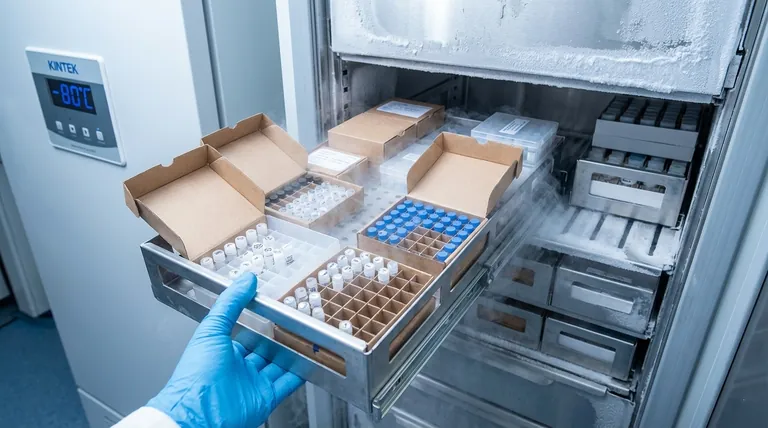
The Foundation of ULT Storage: Systemic Organization
Properly storing samples at temperatures between -40°C and -86°C requires more than just placing them in the cold. It demands a systematic approach that protects the samples and the user.
The Primary Container: Vials and Tubes
The first layer of storage is the container holding the sample itself. These are typically polymer tubes and microtubes specifically designed to withstand extreme cold without becoming brittle or cracking.
Secondary Organization: Storage Boxes
These tubes are then organized into storage boxes. These boxes contain grid dividers that typically hold 64, 81, or 100 individual tubes, allowing for clear cataloging and grouping of related samples.
Tertiary Structure: Freezer Racks
Finally, the boxes are loaded into metal freezer racks. These racks are designed to fit the specific dimensions of the freezer shelves, maximizing storage capacity and making it much easier to locate and retrieve a specific box without disturbing others. A standard ULT freezer can hold approximately 350 to 450 of these boxes.
Why This System is Critical for Sample Integrity
The layered organization directly supports the core purpose of a ULT freezer: the long-term preservation of highly sensitive biological materials.
Minimizing Temperature Fluctuations
Every time a freezer door is opened, warm air enters and raises the internal temperature. The rack and box system allows researchers to quickly identify and remove only the specific box they need, minimizing door-open time and protecting all other samples from a damaging temperature swing.
Preserving Sensitive Materials
ULT freezers are essential for the long-term storage of materials that degrade rapidly at warmer temperatures. This includes cells, tissues, proteins, enzymes, DNA, and modern vaccines. The stable, ultra-low environment halts biological activity, preserving them for future use.
Ensuring a Controlled Environment
The freezers themselves are engineered to support this system. They are built with robust insulation, tightly sealed doors, and often feature stainless steel interiors for cleanliness and durability. This construction works in tandem with the organized storage to maintain a stable environment.
Managing the Inevitable Risks
While highly effective, ULT storage is not without risk. The system is designed to mitigate the two primary threats: equipment failure and human error.
The Threat of Equipment Failure
A ULT freezer malfunction can be catastrophic, potentially destroying years of research or valuable medical supplies. Modern freezers are built with sophisticated temperature control systems that use sensors and feedback loops to maintain a precise temperature.
The Role of Monitoring and Alarms
To guard against failure, nearly all ULT freezers are equipped with audible and visual alarm systems. These systems are designed to trigger alerts when the temperature deviates from the set range, and they can remotely notify personnel in the event of a power outage or cooling system failure.
The Impact of Human Error
An unorganized freezer is a significant liability. Without a clear inventory system that maps the location of every tube within every box and rack, finding a specific sample becomes a time-consuming and disruptive process, increasing the risk of temperature damage to all samples.
Key Principles for Effective ULT Storage
To ensure the viability of your samples, your storage strategy must align with your primary objective.
- If your primary focus is long-term preservation: Use high-quality, cryo-compatible tubes and boxes to prevent material failure and ensure meticulous labeling on every sample.
- If your primary focus is sample accessibility: Implement a rigorous inventory management system that maps the precise location of every sample before it ever enters the freezer.
- If your primary focus is risk mitigation: Ensure your freezer's alarm system is tested regularly and connected to a reliable remote notification service that can alert multiple team members 24/7.
Ultimately, this systematic approach to organization is the cornerstone of safe and effective long-term biological storage.
Summary Table:
| Storage Component | Purpose | Key Details |
|---|---|---|
| Vials/Tubes | Primary sample container | Made from polymers that withstand extreme cold without cracking. |
| Storage Boxes | Secondary organization | Feature grid dividers (e.g., for 81 or 100 tubes) for cataloging. |
| Freezer Racks | Tertiary structure | Metal racks hold boxes, maximizing capacity and enabling quick retrieval. |
Ensure the integrity of your valuable biological samples with the right equipment.
KINTEK specializes in providing reliable lab equipment and consumables for all your laboratory needs. Our range of ultra-low temperature freezers and compatible storage solutions is designed to offer the precise temperature control, robust construction, and organizational efficiency your lab requires for the long-term preservation of cells, tissues, vaccines, and other sensitive materials.
Let our experts help you build a storage system that minimizes risk and maximizes accessibility. Contact KINTEK today to find the perfect ULT storage solution for your lab.
Visual Guide

Related Products
- 508L Advanced Vertical Ultra Low Temperature Freezer for Critical Laboratory Storage
- 408L Advanced Vertical Laboratory Ultra Low Temperature Freezer for Critical Research Material Preservation
- 58L Precision Laboratory Ultra Low Temperature Upright Freezer for Critical Sample Storage
- 158L Precision Vertical Ultra Low Freezer for Laboratory Applications
- 808L Precision Laboratory Vertical Ultra Low Temperature Freezer
People Also Ask
- How do Ultra-Low Temperature freezers ensure the integrity of microbiological samples? Maintain Stability for Critical Research
- What makes Ultra-Low Temperature freezers energy efficient? Key Design & Operational Strategies
- What advantages do ultra-low temperature freezers offer? Ensure Long-Term Sample Integrity and Reliability
- What is the price range for ultra low temperature freezers? Protect Your Samples with the Right Investment
- What are ultra low temperature freezers used for? Preserving Critical Biological Samples for Decades
